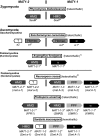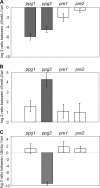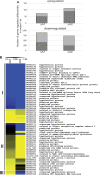Functional characterization of MAT1-1-specific mating-type genes in the homothallic ascomycete Sordaria macrospora provides new insights into essential and nonessential sexual regulators
- PMID: 20435701
- PMCID: PMC2901639
- DOI: 10.1128/EC.00019-10
Functional characterization of MAT1-1-specific mating-type genes in the homothallic ascomycete Sordaria macrospora provides new insights into essential and nonessential sexual regulators
Abstract
Mating-type genes in fungi encode regulators of mating and sexual development. Heterothallic ascomycete species require different sets of mating-type genes to control nonself-recognition and mating of compatible partners of different mating types. Homothallic (self-fertile) species also carry mating-type genes in their genome that are essential for sexual development. To analyze the molecular basis of homothallism and the role of mating-type genes during fruiting-body development, we deleted each of the three genes, SmtA-1 (MAT1-1-1), SmtA-2 (MAT1-1-2), and SmtA-3 (MAT1-1-3), contained in the MAT1-1 part of the mating-type locus of the homothallic ascomycete species Sordaria macrospora. Phenotypic analysis of deletion mutants revealed that the PPF domain protein-encoding gene SmtA-2 is essential for sexual reproduction, whereas the alpha domain protein-encoding genes SmtA-1 and SmtA-3 play no role in fruiting-body development. By means of cross-species microarray analysis using Neurospora crassa oligonucleotide microarrays hybridized with S. macrospora targets and quantitative real-time PCR, we identified genes expressed under the control of SmtA-1 and SmtA-2. Both genes are involved in the regulation of gene expression, including that of pheromone genes.
Figures





References
-
- Astell C. R., Ahlstrom-Jonasson L., Smith M., Tatchell K., Nasmyth K. A., Hall B. D. 1981. The sequence of the DNAs coding for the mating-type loci of Saccharomyces cerevisiae. Cell 27:15–23 - PubMed
-
- Bell S. P., Dutta A. 2002. DNA replication in eukaryotic cells. Annu. Rev. Biochem. 71:333–374 - PubMed
-
- Blakeslee A. 1904. Sexual reproduction in the Mucorinae. Proc. Am. Acad. Sci. 40:205–319
Publication types
MeSH terms
Substances
Grants and funding
LinkOut - more resources
Full Text Sources
Molecular Biology Databases

